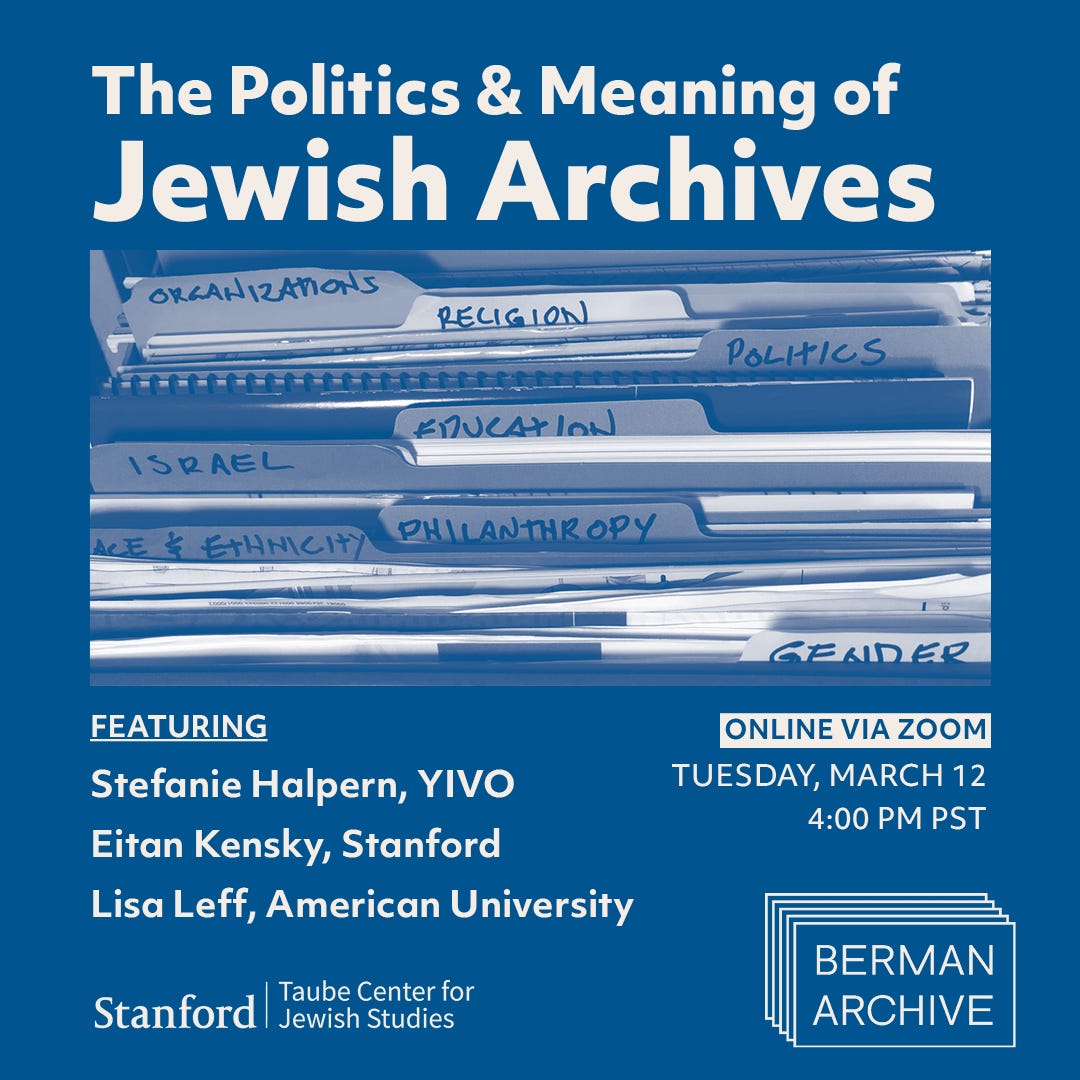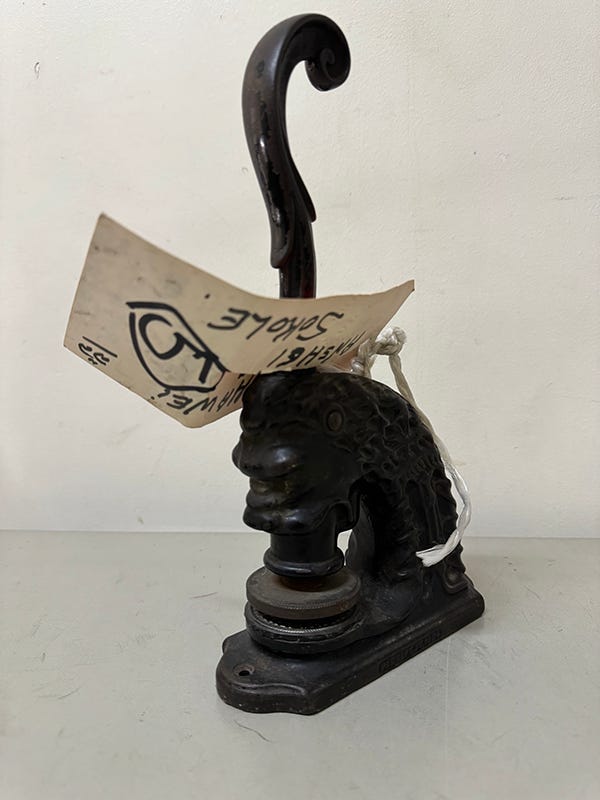Conflict and the Archive
Hello and welcome to the February 2024 edition of the Documensch Newsletter. This week, President Biden hinted at a ceasefire while holding an ice cream cone a day after an active service officer died from his self-immolation in front of the Israeli Embassy in Washington in protest of the mounting civilian deaths in Gaza. The absurdity and gravity of this moment are abundantly clear. As always, we look to the past to help us understand our current moment and to offer us informed visions for a better future.
This month, we explore the politics and meaning of Jewish archives in anticipation of our March 12 virtual event. In collaboration with JPRO, we mine previous discussions of conflict management in the American Jewish Community. And we look to previous divisions in Jewish advocacy in America.
As always, reach out with feedback, suggestions of articles we should consider sharing, or ideas for documents we should consider archiving. We can be reached at bermanarchive@stanford.edu.
Thanks for reading,
-Ari
Ari Y Kelman, Director, Berman Archive
March 12: The Politics & Meaning of Jewish Archives

We’re a few weeks away from our online event to discuss the history, politics, and meaning of Jewish archives with 3 leading experts in the field. Join us as we consider questions of provenance and motivations for creating specifically Jewish archives, as well as the collections and description practices that mark them. We’ll also delve into who exactly these archives are for and explore ways that collections can be useful and meaningful for researchers, Jewish professionals, and anyone with an interest in engaging with artifacts from the past.
To get us all in the right archival frame of mind, we asked some of our panelists to share their favorite archival finds. Stefanie Halpern, Director of the Archives at the YIVO Institute for Jewish Research, shared a photo of a Landsmanshaft handpress seal:
This ornately decorated handpress seal belonged to Congregation Ahava Scholem Ansche Sakolem. Organized on April 17, 1909 according to the seal, Congregation Ahava Scholem was one of the thousands of landsmanshaftn—mutual aid societies—setup by Jewish immigrants in the United States in the late 19th and early 20th centuries. These handpresses were used to emboss the seal of the landsmanshaft onto official documents.
Lisa Leff, author of The Archive Thief and Professor of History at American University, shared a recent reflection she wrote for the Jewish Quarterly Review about a French newspaper clipping from 1961 that told the sensational (and in many ways false) story of a set of archival documents that were stolen with the help of a razor blade. The journalist, explained Leff, “presented the crime as a politically motivated international conspiracy.” This article set her on an archival journey that illuminated both the fuller truth of the theft and offered a glimpse “into a particular moment in the history of Jewish history-making in France.” By reading around the newspaper article and examining court and police reports, Leff was able to paint a fuller picture of the thief, and the broader context of Jews and Jewish historical scholarship in France and Europe in the early 1960s.
We look forward to hearing about the politics and meaning of these, and many other archival discoveries at our event on March 12.
Conflict Management in the Jewish American Archive
The Berman Archive recently collaborated with JPRO to offer some documents and analysis in support of the February 12 “Zoom In with JPRO” event on Conflict Management. Here’s what we shared:
Conflict is nothing new to American Jewish life and the Berman Archive at Stanford University documents part of the history of how American Jewish organizations and communities have weathered previous moments of conflict.
Conflict management is often thought of in its most immediate and visceral moments—a reaction to situations in the workplace and the world that can’t be ignored. Since the Hamas terror attacks on Israel on October 7, 2023, the Jewish professional world has had to grapple with new tensions that have arisen in workplaces.
What follows are a few examples of how American Jewish communal organizations have managed conflict in the past. We hope they can give broader context and historical understanding to the issues we’re all grappling with today in our respective Jewish workplaces.
Conflict in Politics
Writing in the 1993 issue of Sh’ma: a Journal of Jewish Responsibility, cultural anthropologist Riv-Ellen Prell offered a reflection on her circumstances that could easily have been written in 2023:
I often feel that the politics that liberated me created a golem which is destroying the very arenas of political activism which I care most about. The alliances around affinity and identity which seemed so powerful nearly thirty years ago appear very limited to me today.
Prell was wrestling with conflict in her community, born of her experience of political action and activism in the late 1960s. Her article, which was the lead piece in the issue of Sh’ma, was followed by a number of responses, each addressing some aspect of the challenges of political affinity in the Jewish community.
Leadership Amidst Division
In 1999, Deborah Lipstadt, historian and current US Special Envoy to Monitor and Combat Antisemitism, diagnosed the dynamics of division in North American Jewry in 1999 with her article “A Challenge of Leadership: Building Jewish Community in an Age of Diminishing Consensus.” Lipstadt tried to sketch out a vision for communal leadership amidst divisions arguing both that “Jewish unity is an illusion, and that attempts to build consensus are futile” and, ironically, that “both pessimists and optimists are right.”
Communal vs. Personal Values
In 1958, a group of authors writing in the Journal of Jewish Communal Service described the tensions between American Jews and the organizations that were supposed to serve them. The authors admit that they are aware that “Many values we hold as social workers are not in consonance with those now held by a substantial part of the Jewish community.” But they nevertheless commit to the values and belief in Jewish community that brought them to the work in the first place.
Conflict in Jewish Communal Tradition
In some ways, what Jewish organizations are seeing now is not new. In 1925, Boris Bogen spoke at the National Conference of Jewish Social Services where he identified the forces that unite and divide the Jewish community. More interesting than his specific examples of unifying and dividing forces is his acceptance of conflict and difference as a feature of Jewish communal life. “Among ourselves,” he observed, “we know that there is no unity in the House of Israel.”
The Diversity of Jewish Advocacy in America
Earlier this month, President Biden visited New York City where he was met with two stark sides of the current Jewish American advocacy movement. The Forward’s report on Biden’s visit showed both the vocal, anti-war movement led by Jewish Voice for Peace, and the often less publicly visible, but passionate and powerful contingent of those who approve of Biden’s support for Israel. Biden’s New York trip was a moment that showed the clear fissure among the most vocal groups of Jewish activists, and how American Jews hold starkly opposing perspectives on the US’s responsibility toward Israel, the responsibility of American Jews toward Israel, and the relationship between Zionism, anti-Zionism, and antisemitism.
These debates and disagreements have a long history in American Jewish life, as do strategies for advocacy and organization. Anyone wishing to understand the current moment better would benefit from a look into past efforts to square these issues.
In 1984, the Centre for Contemporary Studies hosted a symposium titled, “Anti-Semitism, Zionism, The Link.” The report from the symposium shows the breadth of discussion and discourse around the question of Anti-Zionism and the ways it is deployed problematically by the left and right. We also have the proceedings of a symposium on “Anti-zionism and Anti-semtism” from 1983 with perspectives from Yehuda Bauer and Bernard Henri Levy, to name a few.
In 1979 the American Jewish Committee produced a report on “Anti-Israel Influence in American Churches.” The report describes the major sources of anti-Israel, pro-Arab sentiment within the organized Christian community in the U.S. Then, like now, sentiment is divided between views that are supportive of Palestinian refugees and views that stem from specifically anti-Jewish sentiment.
Further back, in 1943, it was intra-Jewish divisions around Zionism that exacerbated the split between the American Jewish Committee and the American Jewish Conference. We have then American Jewish Committee President Joseph Proskauer’s statement where he describes the impetus for the break:
The resolutions with respect to Palestine were thus adopted without opportunity to effect a possible adjustment between ultimate political Zionist aspirations and the position held by a vast number of Jews not affiliated with official Zionist bodies. These resolutions were, in our judgment, not in the best interests of Jews throughout the world, including Palestine. Therefore, we had no alternative but to dissent.
Then, as now, war rages on. The organizations that claim to speak for Jews across the political spectrum have long been engaged with battles both external and internal to the Jewish community. While conflict is rarely pleasurable, it is a reflection of the diversity of thought and strength of conviction that has long characterized the American Jewish community.

